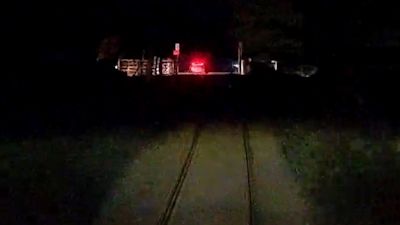Train travelling at 75mph narrowly missed two cars after drivers failed to check crossing in Norfolk

A passenger train came within seconds of hitting two vehicles at a level crossing because the car drivers had not called the signaller to check the route was clear, an investigation found.
The cars were travelling over the user-operated crossing in Coltishall Lane near Hoveton in Norfolk as drivers searched for an alternative route due to a traffic accident on a nearby main road.
The near miss happened in the dark at 5.21pm on 21 January last year.
Investigators from the Rail Accident Investigation Branch recorded that the first car cleared the crossing around two seconds before the train arrived.
The second car, following the first, entered the crossing but stopped just short of the railway line, around a second before the train’s arrival.
The train was travelling at 75mph, with the driver sounding the warning horn then applying the emergency brakes after seeing seeing the headlights of the first car.
The train passed over the crossing at 58mph and came to a stop about 260 metres beyond the crossing, with nobody injured and no damage caused.
Signs at crossing 'ineffective'
The RAIB found that the drivers did not call the signaller before crossing and this may have been because they were unfamiliar with the crossing.
It may also have been because signs at the crossing were “ineffective in prompting users on how to cross safely”, and because the level crossing gates had already been opened, according to the report.
Investigators said the increased level of road traffic caused by accident on the nearby main road “may have affected the behaviour of road users and their decision-making”.
The RAIB said Network Rail and its predecessors had not taken measures to close or upgrade the crossing “despite being aware of the risks it posed”.
The report made a series of recommendations, including that Network Rail should assess the risks of accidents at user-operated crossings which may see significant use by unfamiliar users, and if necessary reduce the risks.
It also recommended that signage should be improved at user-operated crossings.
Bringing change 'too difficult'
Andrew Hall, chief inspector of rail accidents, said: “RAIB has investigated many accidents and incidents over the last 16 years and noted considerable improvement in the way risk at many types of level crossing is managed.
“However, we feel at present the greatest scope for safety improvement exists at user-worked crossings, whether on private or public roads.
“The significant number of such crossings on public roads is of concern because most motorists are unlikely to be familiar with the concept of a level crossing which they must operate themselves.
“Because of this, they may not use the crossing safely as was the case in this incident."
He added: “Over more than 20 years, the railway was aware that the safety arrangements at this crossing should be improved, but it seems that bringing about such change was too difficult.
“The regulatory structure in place to oversee level crossing safety did not result in action being taken at this crossing in time to avoid this incident.
“Our recommendations seek to promote safety improvements at user-worked crossings on public roads and to check that regulatory actions being taken to make such improvements easier to achieve have the desired effect.”